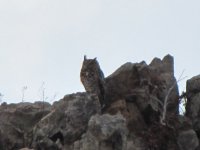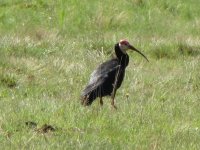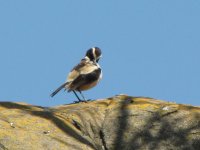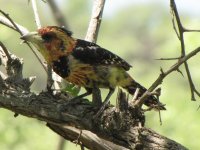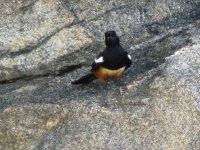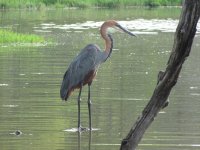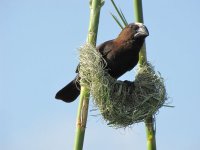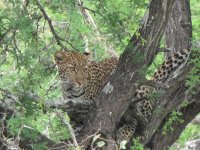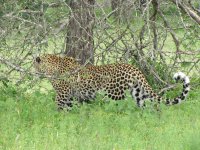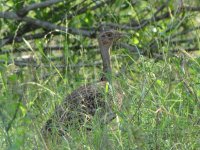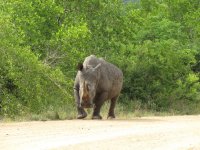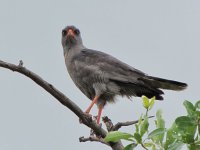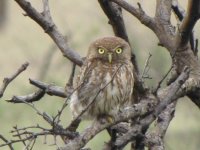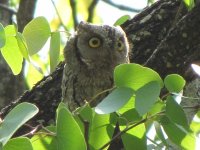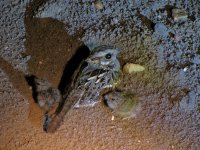Larry Sweetland
Formerly 'Larry Wheatland'
Ok, here's an attempt at another 'live' trip report, not sure how much I'll be able to keep it up. It's our first trip to southern Africa, 10 days in Gambia being my only experience of sub saharan Africa, so I'm pretty excited.
Nicky and I flew from Heathrow to Johannesburg direct, with South African airlines, arriving late morning yesterday. We had pre-booked (unlike us) 2 nights in the 1322 Backpackers in eastern Pretoria (280 ZAR/night, for a double) and had arranged (very unlike us!) taxi pick-up from the airport for 40 ZAR. We figured on needing a couple of days to recover and sort out hiring a car and settling in. The hostel has a kitchen, and food at a supermarket 10mins walk away is generally a bit cheaper than in Bristol.
Before we had got off the plane I'd managed a couple of identifiable lifers: Blacksmith Plover and Cape Sparrow, but the drive to the hostel was mostly chomping at the bit, with various unidentifiable flying somethings. Whoopee we're here! The hostel itself was in the leafy suburb of Hatfield, east of central Pretoria, and the small garden was (for me) worth exploring. Standing on a bench and peering over a wall has produced a zonking male African Paradise Flycatcher, and when I looked overhead I was somewhat surprised to see a circling African Darter. A short walk down the road darter-wards revealed that we were next door to the university campus, which has a small swamp-fringed lake, so I have managed to explore this area a bit over yesterday and today, in between sorting out walking to the shops etc. Nicky's not been well tummywise unfortunately, but appears to be getting better now, and has made it to the campus lake once too.
Before making it into the campus compound, the goodies started to file in, in the order of the list below. It was seeing Thick-billed Weaver through the campus' fence that really made me think 'wow, what's this place and how can I get in there?!' Pretty much everywhere we've seen in Pretoria is enclosed in tall fencing, mostly electrified, but the gate staff at the campus entrance were ok with me entering for birding purposes, though only when I showed them my binoculars were not a camera.
So here's the list so far (lifers in big bold and intros in brackets):-
1 BLACKSMITH PLOVER
2 (Rock Dove)
3 Pied Crow
4 CAPE SPARROW
5 Sacred Ibis
6 (Common Myna)
7 African Paradise Flycatcher
8 AFRICAN DARTER
9 Little Swift
10 African Palm Swift
11 Black-headed Heron
12 DARK-CAPPED BULBUL
13 KAROO THRUSH
14 Laughing Dove
15 SOUTHERN MASKED WEAVER
16 SOUTHERN GREY-HEADED SPARROW
17 AFRICAN HOOPOE
18 CROWNED LAPWING
19 House Sparrow
20 HADEDA IBIS
21 CAPE TURTLE DOVE
22 Cattle Egret
23 GREY GO-AWAY BIRD
24 CAPE WHITE-EYE
25 African Grey Hornbill
26 AFRICAN OLIVE PIGEON
27 CAPE ROBIN-CHAT
28 Crested Coot
29 FISCAL SHRIKE
30 CRESTED BARBET
31 THICK-BILLED WEAVER
32 Moorhen
33 EGYPTIAN GOOSE
34 Swallow
35 Reed Cormorant
36 WHITE-BREASTED CORMORANT
37 Grey Heron
38 Tawny-flanked Prinia
39 Pied Kingfisher
40 SOUTHERN RED BISHOP
41 SPECKLED MOUSEBIRD
42 Pin-tailed Whydah
43 CAPE WAGTAIL
44 Black-winged Kite
45 WHITE-THROATED SWALLOW
46 Purple Heron
47 (Mallard)
48 White-rumped Swift
49 GREATER STRIPED SWALLOW
50 GROUNDSCRAPER THRUSH
51 LESSER STRIPED SWALLOW
52 STREAKY-HEADED SEEDEATER
53 BLACK CRAKE
54 AFRICAN BLACK DUCK
55 CAPE GLOSSY STARLING
56 BLACK-COLLARED BARBET
57 KURRICHANE THRUSH
58 Speckled Pigeon
59 Village Weaver
60 THREE-BANDED PLOVER
61 BLACK-THROATED CANARY
There's a colony of Cattle Egrets, African Darters and Black-headed Herons on the lake. Most of the birds listed have been in good numbers, and I'm guessing there's nothing unusual in there (?). Personnal faves have been Groundscraper Thrush (1), Streaky-headed Seedeater (2), Black-throated Canary (1), Black Crake (1), African Black Duck (3) a group that popped in to the lake briefly on one visit, and of course totally loopy-looking stuff like the Red Bishops, Pin-tailed Whydahs, Speckled Mousebirds, and pretty much all of it come to think of it. Well I mustn't grumble at 35 lifers without even really going anywhere yet!
We goofed a bit with hiring a car, and should have done it at home in advance, as it would have been cheaper. We've now sorted a little one out though which is a bit under 300 pounds for 3 weeks. We hope to return it after doing a bit of a loop to the northeast, taking in Kruger NP, and then we're booked on a train to Cape Town.
As with our other 'live' reports, all suggestions are welcome, and helpful 'nudges' if you think I'm likely to have cocked up an ID etc. We're mostly using the Southern African Birdfinder book for gen, but have BIrdboybowley's trip report printed out and have looked at a few others, eg Jos's. We have the SASOL field guide, but I've just seen a newer edition and the illustrations look greatly improved for some of the tricky birds like larks and cisticolas. Drat!
Nicky and I flew from Heathrow to Johannesburg direct, with South African airlines, arriving late morning yesterday. We had pre-booked (unlike us) 2 nights in the 1322 Backpackers in eastern Pretoria (280 ZAR/night, for a double) and had arranged (very unlike us!) taxi pick-up from the airport for 40 ZAR. We figured on needing a couple of days to recover and sort out hiring a car and settling in. The hostel has a kitchen, and food at a supermarket 10mins walk away is generally a bit cheaper than in Bristol.
Before we had got off the plane I'd managed a couple of identifiable lifers: Blacksmith Plover and Cape Sparrow, but the drive to the hostel was mostly chomping at the bit, with various unidentifiable flying somethings. Whoopee we're here! The hostel itself was in the leafy suburb of Hatfield, east of central Pretoria, and the small garden was (for me) worth exploring. Standing on a bench and peering over a wall has produced a zonking male African Paradise Flycatcher, and when I looked overhead I was somewhat surprised to see a circling African Darter. A short walk down the road darter-wards revealed that we were next door to the university campus, which has a small swamp-fringed lake, so I have managed to explore this area a bit over yesterday and today, in between sorting out walking to the shops etc. Nicky's not been well tummywise unfortunately, but appears to be getting better now, and has made it to the campus lake once too.
Before making it into the campus compound, the goodies started to file in, in the order of the list below. It was seeing Thick-billed Weaver through the campus' fence that really made me think 'wow, what's this place and how can I get in there?!' Pretty much everywhere we've seen in Pretoria is enclosed in tall fencing, mostly electrified, but the gate staff at the campus entrance were ok with me entering for birding purposes, though only when I showed them my binoculars were not a camera.
So here's the list so far (lifers in big bold and intros in brackets):-
1 BLACKSMITH PLOVER
2 (Rock Dove)
3 Pied Crow
4 CAPE SPARROW
5 Sacred Ibis
6 (Common Myna)
7 African Paradise Flycatcher
8 AFRICAN DARTER
9 Little Swift
10 African Palm Swift
11 Black-headed Heron
12 DARK-CAPPED BULBUL
13 KAROO THRUSH
14 Laughing Dove
15 SOUTHERN MASKED WEAVER
16 SOUTHERN GREY-HEADED SPARROW
17 AFRICAN HOOPOE
18 CROWNED LAPWING
19 House Sparrow
20 HADEDA IBIS
21 CAPE TURTLE DOVE
22 Cattle Egret
23 GREY GO-AWAY BIRD
24 CAPE WHITE-EYE
25 African Grey Hornbill
26 AFRICAN OLIVE PIGEON
27 CAPE ROBIN-CHAT
28 Crested Coot
29 FISCAL SHRIKE
30 CRESTED BARBET
31 THICK-BILLED WEAVER
32 Moorhen
33 EGYPTIAN GOOSE
34 Swallow
35 Reed Cormorant
36 WHITE-BREASTED CORMORANT
37 Grey Heron
38 Tawny-flanked Prinia
39 Pied Kingfisher
40 SOUTHERN RED BISHOP
41 SPECKLED MOUSEBIRD
42 Pin-tailed Whydah
43 CAPE WAGTAIL
44 Black-winged Kite
45 WHITE-THROATED SWALLOW
46 Purple Heron
47 (Mallard)
48 White-rumped Swift
49 GREATER STRIPED SWALLOW
50 GROUNDSCRAPER THRUSH
51 LESSER STRIPED SWALLOW
52 STREAKY-HEADED SEEDEATER
53 BLACK CRAKE
54 AFRICAN BLACK DUCK
55 CAPE GLOSSY STARLING
56 BLACK-COLLARED BARBET
57 KURRICHANE THRUSH
58 Speckled Pigeon
59 Village Weaver
60 THREE-BANDED PLOVER
61 BLACK-THROATED CANARY
There's a colony of Cattle Egrets, African Darters and Black-headed Herons on the lake. Most of the birds listed have been in good numbers, and I'm guessing there's nothing unusual in there (?). Personnal faves have been Groundscraper Thrush (1), Streaky-headed Seedeater (2), Black-throated Canary (1), Black Crake (1), African Black Duck (3) a group that popped in to the lake briefly on one visit, and of course totally loopy-looking stuff like the Red Bishops, Pin-tailed Whydahs, Speckled Mousebirds, and pretty much all of it come to think of it. Well I mustn't grumble at 35 lifers without even really going anywhere yet!
We goofed a bit with hiring a car, and should have done it at home in advance, as it would have been cheaper. We've now sorted a little one out though which is a bit under 300 pounds for 3 weeks. We hope to return it after doing a bit of a loop to the northeast, taking in Kruger NP, and then we're booked on a train to Cape Town.
As with our other 'live' reports, all suggestions are welcome, and helpful 'nudges' if you think I'm likely to have cocked up an ID etc. We're mostly using the Southern African Birdfinder book for gen, but have BIrdboybowley's trip report printed out and have looked at a few others, eg Jos's. We have the SASOL field guide, but I've just seen a newer edition and the illustrations look greatly improved for some of the tricky birds like larks and cisticolas. Drat!
Last edited:







